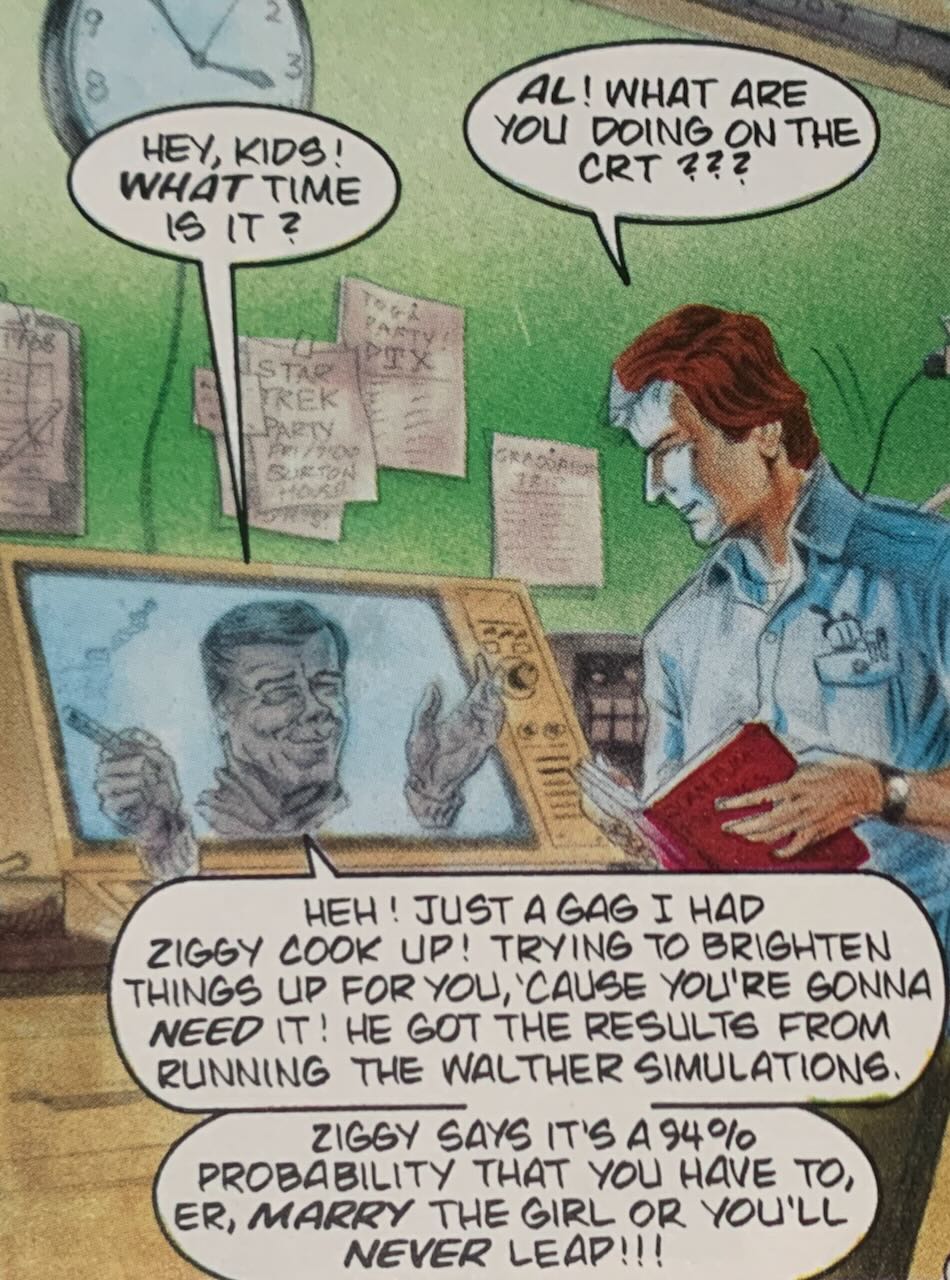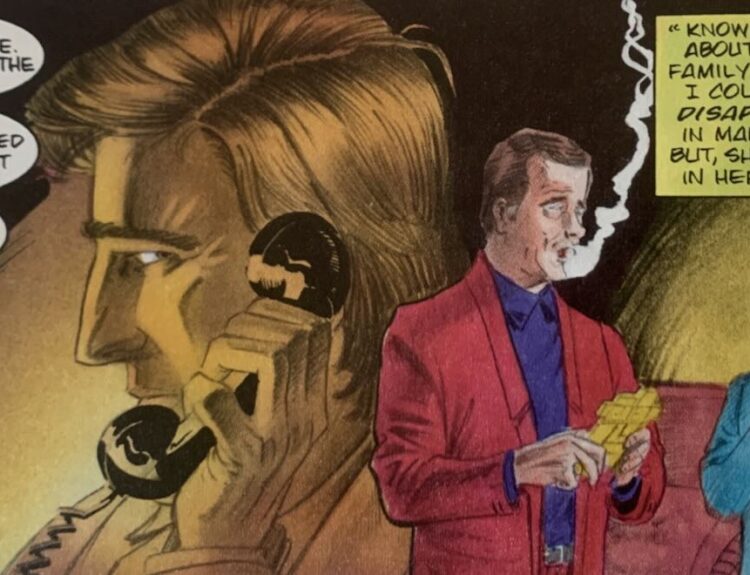Sam leaps into an MIT student whose girlfriend is supposed to make a critical discovery that will help to inspire Project Quantum Leap itself. Sam’s arrival threatens this discovery and the girlfriend’s whole career, so he must work to fix it.
Writer: Link Yaco. Illustrator: Andy Price. Letterer: Vickie Williams. Colorist: Scott Rockwell. Editor: George Broderick, jr. Research and consultation; M.B. Stenzel, Asst. Prof. U. of C. and R. Winchester, Telecom. Spec., MIT.

Previous Story: He Knows if You’ve Been Bad or Good (Quantum Leap #3a) • Next Story: The $50,000 Quest (Quantum Leap #4)
Comments:
The Infinite Corridor is the second story in issue #3 of Quantum Leap, following He Know if You’ve Been Bad or Good. In one way, The Infinite Corridor does the better job of the two at working within the confines of that length–it has less things going on, so it doesn’t feel as crowded or hampered by the shorter page count. But at the same time, that means it has less going on, which it feel less substantial. It comes across like a back-up story, even though it’s about the same length as the first one (and technically, a page longer because it includes the teaser for the next issue).

The situation is that Sam is an MIT student whose brilliant girlfriend Ellen Kim is supposed to make a big discovery which will revolutionize understanding in her field, but because of his accidental interference, both her long-term career and this specific event are both in jeopardy. So Sam has to patch up their messed-up romance (since as a women in the 60s, if she marries the wrong guy she won’ be supported in her career), and then later make sure she is in the right place and looking in the right direction to make her critical scientific discovery.
Neither of these situations are developed very well, so there’s not a lot of tension. There is also reference to the notion that Ellen’s discovery actually provided inspiration to Sam himself in the development of Project Quantum Leap, and so if all this goes wrong Sam could mess up his own history and even “create a time paradox that would rip apart all of time and space!” This was, one assumes, added to raise the stakes, but nothing ever comes of it. Instead it just becomes part of an already overlong and over wordy scene between Sam and Al which bogs the first third of the story down with a lot of heavy exposition.

In the end, probably the most notable positive thing about The Infinite Corridor is just the peak it provides into the world of MIT of 1968–the scientific endeavours, the protest movements, and the whole “Stonehenge Effect” (where the sun hits the buildings one day a year to create a unique visual display) which becomes the centrepiece of the story. Plot-wise, the only function it serves is that it’s here that Sam very easily fixes up his romance with Ellen (which was only disrupted because he leapt in in the midst of kissing her and was confused), but it’s where the storytellers seems the most interested in slowing down and spending some time. As such, it probably would have been better if the whole story could have been written to happen more in the midst of the sunset, like a leap where Sam has to do something in only the first ten minutes of his arrival (ideally then freeing up some pages to fix some of the pacing issues in the issue’s first story).
As it is, it feels like even though the plot isn’t too dense, it still lacks focus, and doesn’t make for the most fun read.

Who and Where is Dr. Sam Beckett?
Sam is Matt Randall, an MIT graduate student, at the Massachusetts Institute of Technology in Cambridge, MA. The year is 1968, and the story takes place on one day which is never made specific. However, research tells me that in general, the “Stonehenge Effect” which takes place here and is said to. happen only once a year in real life happens twice a year–once in late January, and once in mid-November. I don’t know if this has somehow changed since 1968.
However, there is chart on the wall which is labelled “April 1968” and Sam also looks at a newspaper which he assumes “Today’s edition of the student newspaper.” It talks about the Stonehenge Effect being that night, so it seems he is right, but it is dated (very faintly) as April 2, 1968. This is actually the date of the assassination of Martin Luthor King, Jr., which was a big focus of Issue #1 of this series. Is this just a creative coincidence? If so, it’s kind of astonishing. If not, it’s confusing–what was the point?

What does Sam have to do?
Sam has to help make sure that Matt Randall’s romantic future with Ellen Kim is secure, and that Ellen makes her discovery about sub-atomic particles going backwards in time.
What do we learn about Sam Beckett?
At the time of this story, Sam was in Junior High, dreaming of MIT. Later Sam did become an MIT undergraduate, during which time he said you could hear a pin drop on the day of the “infinite sunset.”
When he was at MIT, he was study-obsessed, and the kind of guy who would rather work on his dissertation than to kiss a girl. Sam describes his whole experience with Ellen as basically being better than it was when he was really a student.
What do we know about Al?
There’s nothing new here.
What about the experiment?
Ellen Kim’s work to prove that sub-atomic causality is reversible and that time can go backwards convinced Sam that time travel was possible, and so without her work he will never invent his quantum accelerator. As Sam is trying to remember this, he refers to it as “a theory of reverse causality in the collapse of tachyon wave functions.” Al mentions that because of all this, there is concern that this Leap could cause “a time paradox which would erase Sam from history and rip apart all time and space.”

The experiment sounds familiar to Sam – “They have a theory of reverse causality in the collapse of tachyon wave functions that–“
Al claims that there are rules which say he cannot tell Sam too much, or he might interfere with the natural flow of events more than has already has (this again puts emphasis on preserving or restoring time, rather than fixing it or changing it).
Ziggy is trying to replicate Ellen’s experiment but it produces too many possible results for his math co-processors to handle. So Sam suggests using Ziggy’s old “analog test circuitry” which can somehow handle more traffic than his digital stuff.
The clear stakes here are that if Sam doesn’t marry Ellen (or basically do what he has leapt in to do), he will never leap. The Season 5 ides that “Success is not a requirement for leaping” has not come into the lore yet.
“Driven by an unknown force…” (God or Time or Something)
No references to this in this story.
“Oh Boy”
The catchphrase is only heard once, in the teaser to the next issue, where Sam says, “Ohhh, boy…” when he finds he’s on an old gameshow.
Sam’s Complicated Love Life
This story starts and ends with Sam kissing Ellen, and is all about him proving to her that he’s in love with her.

Sam himself seems quite swept up in Ellen, and even playfully hassles Al for interrupting his romantic interlude with her.
The Many Loves of Al Calavicci
Al arrives into the story from a date with someone, where “she” was buying. Sam references the failure of Al’s last two marriages.
Other Observations
• Except for the fact that he’s got messier hair, Matt Randall, based on his reflections, looks almost exactly like Sam.
• There are various easter eggs in the art. Notices around the campus advertise a Star Trek party, a Delta House party announcement (referencing the movie Animal House), a Karloff / Lugosi film festival, and a notice from “Dr. B. Allen” (which sounds a lot like Barry Allen, aka the Flash).

With the Star Trek reference, if this story is happening in. April 1968, it’s just after the second season of the show finished airing, and during the time when fan movements to save the show from cancellation were well underway.
• There’s a bit early on where Al appears to get an electric shock from a monitor in the MIT laboratory. I thought that was going to lead to some interesting things about Al’s hologram in this environment, but it turns out to just be a gag about how Al accidentally touched the bunsen burner where he is heating up his beans.
• A bit later, in a cute bit, Al phases through the monitor Sam is looking at.

• Towards the end of the story, Sam starts to apologise to Ellen by saying, “About the other night…” but the whole story takes place on a single day.
• Inside the back cover, there is a special thanks to colonist Chris Ballard for “leaping in” at the last minute and “helping to put right a schedule that once went wrong.” Chris Ballard isn’t credited for anything in this issue, so I don’t know what he did.
• There is also a little “next issue” advertisement which shows the cover for Issue #4 but labels it Issue #3. Presumably that’s connected to the aforementioned schedule problems.
Sam Leaps To…
The $50,000 Quest (Quantum Leap Issue #4)
Favorite Dialogue
I’m not really impressed with the dialogue in this story. I’ll pick as my favorite a line from Ellen, just because it showcases how ludicrous how this all sounds. When Ellen impetuously breaks up with her boyfriend, she is lettered like this:
I should have known better than to get involved with an MIT Nerd. Go play with your slide ruler and stay out of my life! *sob* *sniff*
The Best Moment
I’m not crazy about this story, but the actual sunset moment is nice. There is some neat golden colouring.

Previous Story: He Knows if You’ve Been Bad or Good (Quantum Leap #3a) • Next Story: The $50,000 Quest (Quantum Leap #4)
News
Berita
News Flash
Blog
Technology
Sports
Sport
Football
Tips
Finance
Berita Terkini
Berita Terbaru
Berita Kekinian
News
Berita Terkini
Olahraga
Pasang Internet Myrepublic
Jasa Import China
Jasa Import Door to Door



